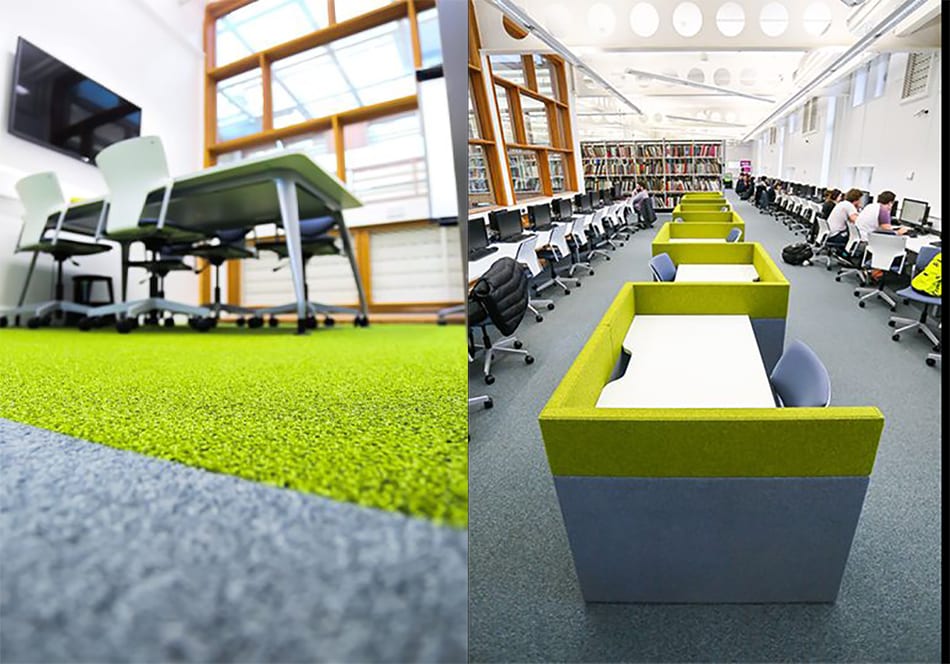Interface: Promoting Calm & Supporting Creativity in Open Plan Spaces
As well-being moves higher up the agenda in many organisations, the need to keep noise levels down – especially in open-plan spaces – is becoming more urgent. Disruptive sounds have a direct effect on productivity, so controlling them through good acoustic design is vital – and flooring has a major role to play.
Global modular flooring specialist, Interface, has helped the University of Coventry to create a flexible, open-plan space in its Frederick Lanchester Library. Such a large, open environment can lead to high noise levels, so good acoustic performance was a key consideration in the project. The design had to cater for both quiet study areas as well as zones for students to work in groups.
The University’s facilities management team wanted to update two floors of the library building to ensure it could accommodate a wide range of student learning activities, and also to bring more natural light into the space. As a recent study by Dahlan and Eissa[1] shows, daylight can have a positive impact on students’ concentration, creativity and productivity, helping to improve their academic performance.
Kirsty Kift, Acting Assistant Director (Learning and Research Support) for the Lanchester Library, explained: “We expect libraries, particularly in an education environment, to be much more than just a study space. Hundreds of our students visit the library every day, not just to research, but also to meet and discuss their courses and collaborate on group projects.”
“By opening up the floors, we could achieve two key goals. We could make sure the library continued to be the go-to building for students looking for a place to study – together or individually – while also creating a greater feeling of light and space to contribute to their wellbeing and offer the best possible environment to help them learn.”
Being open-plan, noise from the social areas could easily have become an issue for people in the quiet zones of the two floors, unless steps were taken to prevent sound carrying across the space. Another floor in the building had previously been made open-plan with hard rubber flooring fitted. This helped to reduce wear, but amplified sound and allowed noise to echo from one end of the floor to the other, disrupting students.
Associated Architects – the firm leading the latest renovation – wanted to prevent these acoustic issues happening on the newly refurbished floors, without compromising on the open-plan goal. The firm recommended modular carpet flooring from Interface to help combine good acoustic performance with a considered design scheme to distinguish the functions of different activity zones.
“Carpet is ideal for use in a large open-plan environment, helping to dampen noise and prevent it carrying across a space,” explained Neil Biddle at Associated Architects. “At the same time, by using modular flooring to create areas of distinctive colours or textures, we can subtly divide the space into specific activity zones. These alterations in the flooring give building users cues that they’ve moved into an area where behavioural changes are required such as quiet zones, for example, helping to further reduce noise levels in designated silent zones.”
Interface supported Associated Architects in sourcing the perfect flooring products to complement its design scheme. On both floors, Interface’s Heuga 580 carpet tiles in the grey-coloured Elephant colourway were used to define the busy computer and desk zones, while blue-grey Urban Retreat 302 Stone tiles were installed in the book-shelf area to distinguish between the spaces for quiet and group activities. The neutral tones of the tiles helped to complement the increased light levels in the newly opened up space, and contribute to its bright, airy atmosphere.
Rough-textured tiles in the colourway Reserved, from Interface’s Composure collection, were used to create walkways to link each zone, while encouraging visitors not to take short cuts through work areas. Break-out spaces and the remaining partitioned meeting rooms were accented with Interface’s Touch & Tones flooring in its green Moss colourway, providing a splash of colour to create a contemporary feel throughout the library.
Not only do the carpet tiles used support the creation of a light, flexible, yet quiet, open-plan library, they also help meet the University of Coventry’s requirement for minimal maintenance – even in areas of heavy footfall. The flooring is highly durable and able to withstand the high traffic experienced in the library. Also, as a modular solution, it allows individual tiles to be replaced when worn without having to remove the entire carpet.
The Lanchester Library has now re-opened it’s newly refurbished floors to visitors and both the quiet and social zones are proving as popular as ever with students.
Kirsty concluded: “When renovating the library, we wanted to do more than simply update the ageing décor. We wanted to create an environment that offered the flexibility to accommodate as wide a range of learning activities as possible, and one that helped to improve the students’ learning experience. The lighter, brighter open-plan interior, combined with the new flooring, has helped us to achieve these goals, ensuring we continue to provide a comfortable, quiet and pleasant for visitors to study in.”
Discover more at Interface.
You might also like...
-
Stiles: Wellness is the New Luxury – And Your Home Needs It

If you have lingered a little too long while viewing a wellness retreat on social media, chances are that Meta has thrown all the wacky ...
-
Yorkwood by Sant’Agostino: The Dream of Tranquil, Understated Country House Elegance

The Yorkwood Range by Sant’Agostino is a Signature Range exclusive to Italtile, offering an elegant and tranquil exploration of understated country house living. Over more ...

























